More info
Genus: Tigriopus
Kingdom: Animalia
Phylum: Arthropoda
Subphylum: Crustacea
Class: Maxillopoda
Subclass: Copepoda
Order: Harpacticoida
Kingdom: Animalia
Phylum: Arthropoda
Subphylum: Crustacea
Class: Maxillopoda
Subclass: Copepoda
Order: Harpacticoida
Genus: Tigriopus
Kingdom: Animalia
Phylum: Arthropoda
Subphylum: Crustacea
Class: Maxillopoda
Subclass: Copepoda
Order: Harpacticoida
Kingdom: Animalia
Phylum: Arthropoda
Subphylum: Crustacea
Class: Maxillopoda
Subclass: Copepoda
Order: Harpacticoida
General characteristics
Copepods are the main primary consumers of microalgae. They constitute more than 70% of the zooplankton components of all the seas.
Sizes range from 120-230 µm.
They are in the main diet of fish and crustaceans. They are omnivorous and cosmopolitan.
They live at high population densities and tolerate a wide range of physical and chemical conditions (temperature, salinity and dissolved oxygen), common in the intertidal zones where they live. They have bento-pelagic habits.
They reproduce sexually and have high fertility. They go through 6 naupliar stages and 6 copepodite stages until they become adults.
Sizes range from 120-230 µm.
They are in the main diet of fish and crustaceans. They are omnivorous and cosmopolitan.
They live at high population densities and tolerate a wide range of physical and chemical conditions (temperature, salinity and dissolved oxygen), common in the intertidal zones where they live. They have bento-pelagic habits.
They reproduce sexually and have high fertility. They go through 6 naupliar stages and 6 copepodite stages until they become adults.
Nutritional value
They are very important for larval diets of marine fish as they have limited enzymatic activity to synthesize, elongate and desaturate polyunsaturated fatty acid chains to long chain highly unsaturated fatty acids. All this is essential since these fatty acids are part of important cellular structures of the nervous system, the retina and other pigmented tissues.
Unlike other live feed used in aquaculture, they do not need to be enriched to have a good balanced level of nutrients as they themselves have an excellent nutritional composition.
Unlike other live feed used in aquaculture, they do not need to be enriched to have a good balanced level of nutrients as they themselves have an excellent nutritional composition.
Advantages of copepods as food
-
Enhances the natural color of fish and crustaceans.
-
Strengthens the body's immune system.
-
They are especially useful with some aquarium inhabitants who are more delicate in their diet, either because they are sick or because they do not accept inert food.
-
Copepods in marine fish larval culture have been shown to ensure normal development with improved growth and survival by greatly reducing disease, malformation and abnormal pigmentation.
When to use copepods and what for
-
Being bento-pelagic, it has a more visible movement to predators and therefore it does not last long in the aquarium once you introduce it, it is consumed more quickly.
-
It can be preyed upon by crustaceans and larger fish.
-
We must add copepods to our aquarium to always ensure a good microfauna in it. It is important not to forget the trophic chains, we must try to imitate the conditions that exist in the sea so that there is a correct functioning at all levels.
-
Copepods are an excellent source of food for more delicate fish and to restore appetite in sick fish or fish that are more difficult to eat (mandarins, pipe fish, seahorses,...) as well as food for corals and invertebrates that live in our aquarium. .
-
We must add them at night so that they are not predated at the moment and always throw them at the opposite end to the water outlet of the tank.
Reviews
No customer reviews for the moment.




